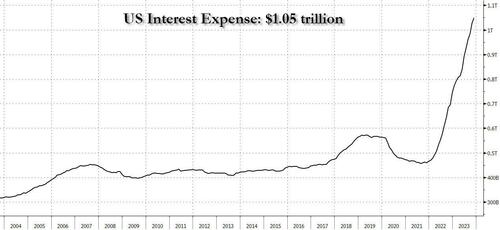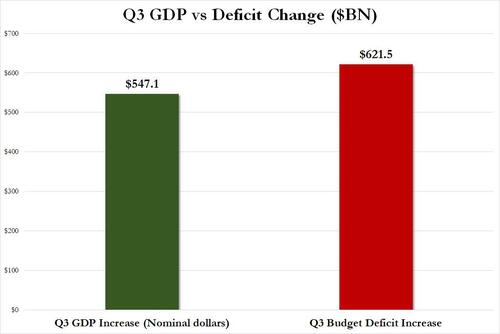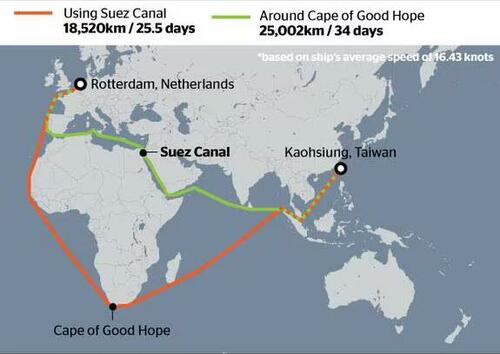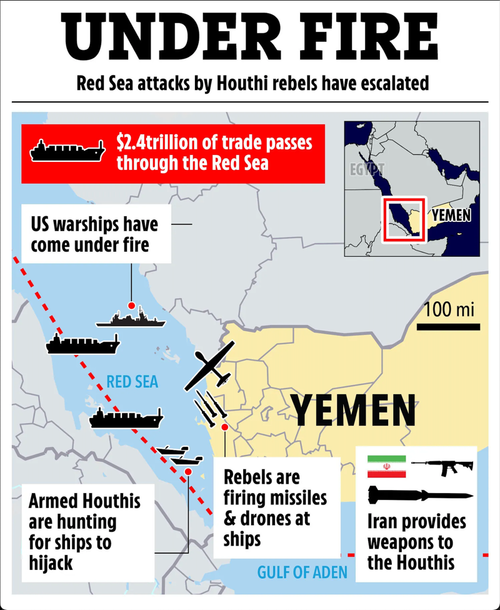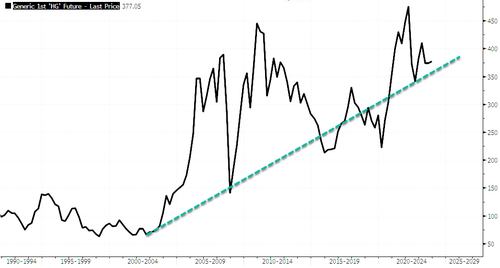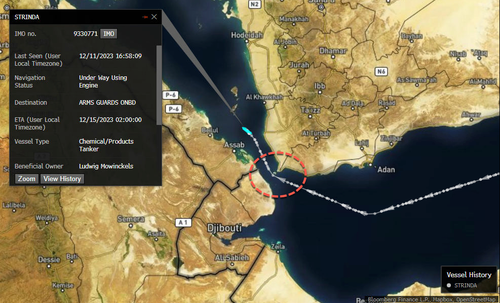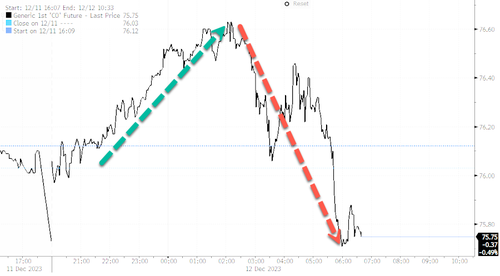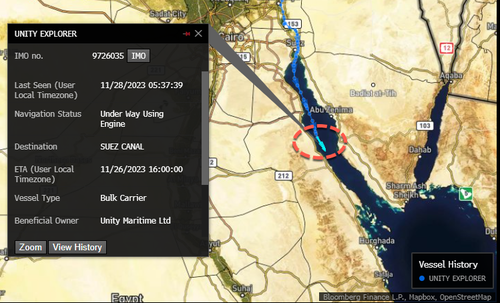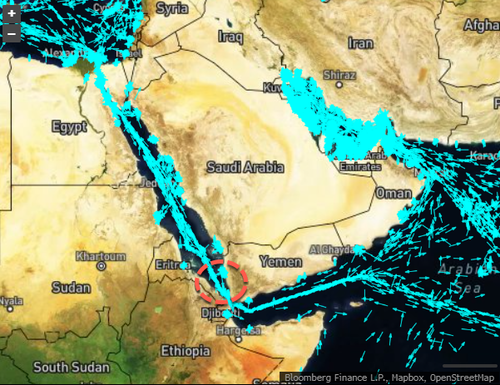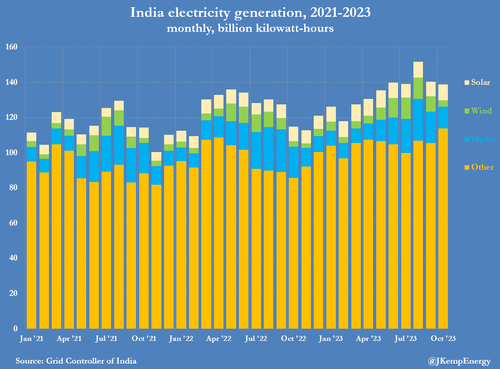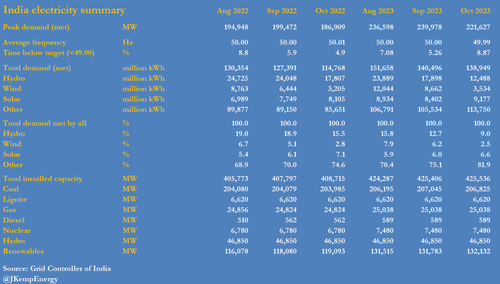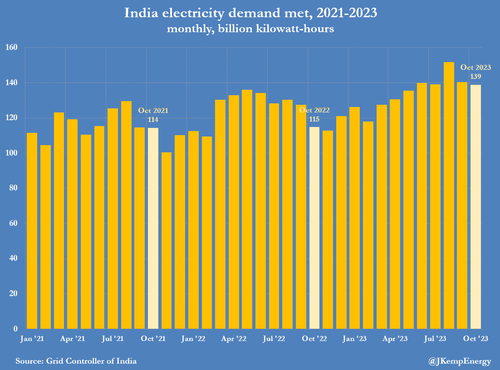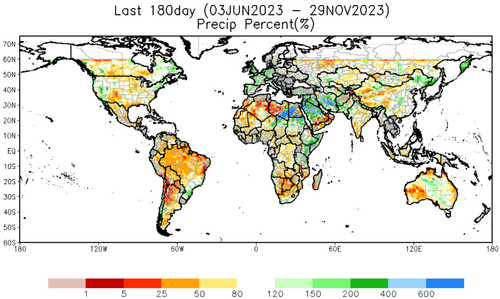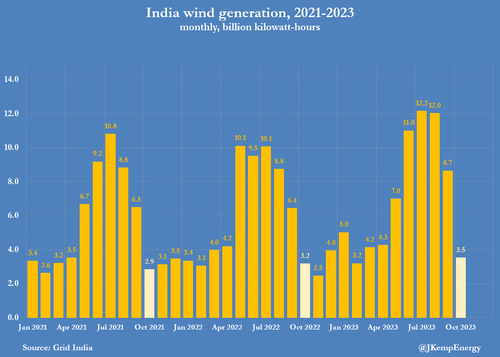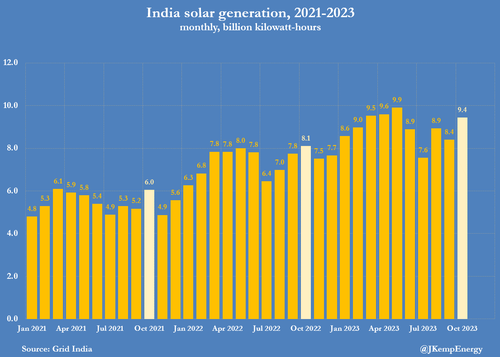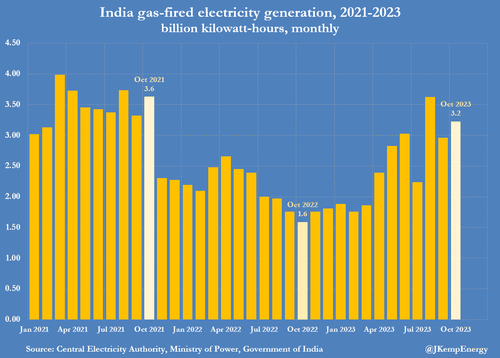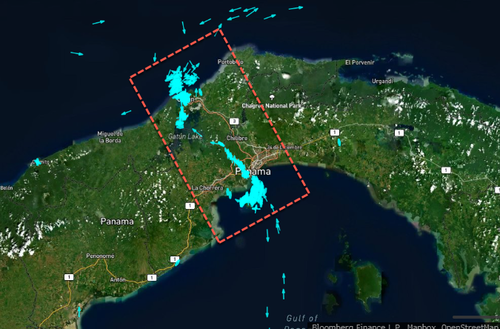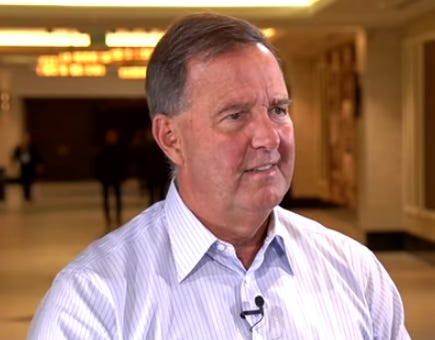Home » Posts tagged 'zerohedge' (Page 6)
Tag Archives: zerohedge
US Debt Hits A Record $34.001 Trillion
US Debt Hits A Record $34.001 Trillion
The US Treasury has a morbid habit of revealing big, round numbers of debt around major calendar milestones, and the new 2024 year was no different because according to the latest Treasury Daily Statement published after the close today and reflecting the US Treasury’s financial statements as of Dec 29, 2023, total US debt as of the end of the year was – drumroll – just over $34 trillion for the first time ever, or $34,001,493,655,565.48 to be precise.
Since this is a topic we have covered more or less daily for our 15 year existence, we don’t need to say much suffice to show a chart of total US debt since zerohedge launched in Jan 2009, when total US debt was only $10.6 trillion. We sure have gone a long way since then.
Some context: US debt increased by…
- $1 trillion in the past 3 months
- $2 trillion in the past 6 months
- $4 trillion in the past 2 years
- $11 trillion in the past 4 years
… and so on. You get the exponential picture. At this point everyone knows how this ends – certainly the CBO does…
… but since there is no way to reverse the catastrophic outcome, there is no point in even talking about it. At best, one may only prepare for the inevitable hyperinflationary outcome, which would be good news to what is now over $1 trillion in interest expense: after all, someone has to devalue the currency all that interest is payable in.
And since there is no longer a way out, we may as well joke about it so consider this: in the third quarter when US GDP supposedly grew at a 4.9% annualized rate – hardly the stuff of recessions – rising $547 billion in nominal (not real) dollars, the US budget deficit increased by a whopping $622 billion.
This not only explains where US “growth” has come from, but begs the question just how much debt will be needed when the US falls into an official recession.
Or actually not, because at this point the best anyone can do is polish the brass on the titanic while waiting for the inevitable, captures so vividly by the following endgame chart.
“This Is Off The Charts”: Economist Claims 2024 Will Bring ‘Biggest Crash Of Our Lifetime’ In US
“This Is Off The Charts”: Economist Claims 2024 Will Bring ‘Biggest Crash Of Our Lifetime’ In US
An economist who focuses on consumer spending has issued a dire warning about the U.S. economy in the coming year.
“Since 2009, this has been 100 percent artificial, unprecedented money printing and deficits: $27 trillion over 15 years, to be exact,” economist Harry Dent told Fox Business on Dec. 19. “This is off the charts, 100 percent artificial, which means we’re in a dangerous state.
“I think 2024 is going to be the biggest single crash year we’ll see in our lifetime.
“We need to get back down to normal, and we need to send a message to central banks,” he said. “This should be a lesson I don’t think we’ll ever revisit. I don’t think we’ll ever see a bubble for any of our lifetimes again.”

As Jack Phillips reports at The Epoch Times, Mr. Dent, who owns the HS Dent Investment Management firm, told the outlet that U.S. markets are currently in a bubble that started in late 2021 amid the COVID-19 pandemic.
“Things are not going to come back to normal in a few years. We may never see these levels again. And this crash is not going to be a correction,” he said.
“It’s going to be more in the ’29 to ’32 level. And anybody who sat through that would have shot their stockbroker,” Mr. Dent said, making references to the stock market crash in 1929 that led to the Great Depression throughout the 1930s.
“If I’m right, it is going to be the biggest crash of our lifetime, most of it happening in 2024. You’re going to see it start and be more obvious by May.
…click on the above link to read the rest…
100 Container Ships Diverted, Insurance Surges As Red Sea Chaos Worsens
100 Container Ships Diverted, Insurance Surges As Red Sea Chaos Worsens
Global transport and logistics company Kuehne + Nagel International AG reports more than 100 container ships have been rerouted from the Red Sea around Africa to avoid Iran-backed Houthi militants in Yemen who attack commercial vessels with missiles and drones.
Bloomberg released two headlines early Wednesday detailing Kuehne + Nagel’s update on the Red Sea. The logistics firm said 103 container ships have detoured around the Cape of Good Hope, lengthening travel time by 1 to 2 weeks. It expects the number of detours to rise in the coming days.
For commercial vessels still transiting the vital waterway that connects to the Suez Canal, Bloomberg noted in a separate report that the cost of insuring jumped this week from about .1% to .2% of the hull value to .5%. A $100 million vessel must pay about $500,000 per voyage.
Increased insurance costs plus more extended travel around the Cape of Good Hope only suggest snarled supply chains and increased prices of goods.
“Both options of increased premiums and rerouting around Africa will see a knock-on effect on the price of goods,” said Toby Vallance, Executive Committee Member of the London Forum of Insurance Lawyers.
Euronav NV Chief Executive Officer Alexander Saverys told Bloomberg TV that the disruption in the Red Sea “will slow down the trade because we will have to wait for a convoy to pass through.” The petroleum tanker giant halted shipments through the Red Sea early this week and won’t transit the region unless there are military escorts. Several other major shipping firms stopped traveling through the area this week (read: here).
Called “Operation Prosperity Guardian,” the Pentagon hasn’t released exact details on how it plans to escort commercial vessels through the conflict region. Vincent Clerc, the chief executive of container shipping giant A.P. Moller-Maersk A/S, said it could take several weeks for the task force to become operational.
…click on the above link to read the rest…
UK Navy Alerted To Incident Near Djibouti As Houthis Paralyze Red Sea Shipping
UK Navy Alerted To Incident Near Djibouti As Houthis Paralyze Red Sea Shipping
International shipping in the Red Sea and vital Bab al-Mandab Strait is grinding to a halt with tankers, container ships, and other types of commercial vessels rerouting around the Cape of Good Hope to avoid missile and drone attacks from Yemen’s Iran-backed Houthis.
In a report that has become almost daily this week, Bloomberg states that the United Kingdom Maritime Trade Operations is monitoring a new potential incident involving a commercial vessel. This latest incident is said to have occurred around 80 nautical miles northeast of Djibouti.
On Monday, Houthi rebels attacked two commercial ships in the Red Sea. Full details of the attacks were not immediately known, but spurred a handful of major shipping companies to halt transit through the Red Sea.
At least seven major shipping companies, including Taiwanese container shipping line Evergreen, Belgian tanker owner Euronav, energy giant BP Plc, Maersk, Hapag-Lloyd, CMA CGM, and Mediterranean Shipping Company have paused all commercial vessel operations through the Red Sea that connects to Egypt’s Suez Canal.
Spillover risks of the Israel-Hamas war are quickly building, as the Red Sea is responsible for 10% to 12% of the world’s international trade. These mounting risks have forced London maritime insurers to demand war risk coverage for vessels that want to transit the Red Sea.
Red Sea is now largely closed to traffic. That’s 8.8 million bpd of daily oil transit, and nearly 380 million tons of daily cargo transit.
Global traffic now will be rerouted around Cape of Good Hope, adding 40% to voyage distance (and even more to cost) pic.twitter.com/Xct7x03tFI
— zerohedge (@zerohedge) December 18, 2023
On Monday, US Secretary of Defense Lloyd J. Austin said the US and allies, including the UK, Canada, France, and others, are creating a new naval task force to protect critical maritime shipping lanes.
…click on the above link to read the rest…
World Could Be At The “Foothills Of The Next Copper Cycle”
World Could Be At The “Foothills Of The Next Copper Cycle”
The world is sliding into a copper deficit over the next couple of years as one of the world’s largest copper mines was forced to shutter operations while demand for the refined metal remains elevated due to renewable energy infrastructure and electric vehicles demand.
Warnings of a copper squeeze come as the Panamanian government recently closed First Quantum Minerals Ltd.’s $10 billion Cobre Panama copper mine, which produces 400,000 tons of copper annually and is considered one of the largest copper mines in the world. This decision emerged after protests and political disputes, culminating in the nation’s Supreme Court canceling the mine’s operating license.
The supply forecast faced further complications with unexpected news from Anglo American Plc last Friday. The miner downgraded copper production forecasts for its operations in South America for the next two years.
Anglo slashed its copper production target for 2024 by 200,000 tons. The forecast noted production levels will drop through 2025. The decline in production is equivalent to a large mine going offline.
Bloomberg pointed out the unexpected removal of 600,000 tons of copper production from First Quantum and Anglo American “would move the market from a large expected surplus into balance, or even a deficit,” adding, It’s also a major warning for the future: copper is an essential metal needed to decarbonize the global economy, which means mining companies will play a key role in facilitating the shift to green energy.”
In June, billionaire mining investor Robert Friedland explained to Bloomberg TV in an interview that copper prices are set to soar because the mining industry is failing to increase supply ahead of ‘accelerating demand.’ He warned:
“We’re heading for a train wreck here.”
Friedland is the founder of Ivanhoe Mines Ltd. He continued, “My fear is that when push finally comes to shove,” copper prices might explode ten times.
…click on the above link to read the rest…
Houthi Rebels Hit Norwegian-Flagged Tanker With Anti-Ship Cruise Missile At Key Maritime Chokepoint
Houthi Rebels Hit Norwegian-Flagged Tanker With Anti-Ship Cruise Missile At Key Maritime Chokepoint
An anti-ship cruise missile fired by Yemen’s Houthi rebels struck a Norwegian-flagged tanker in the Red Sea near a key maritime chokepoint known as the Bab el-Mandeb Strait, where nearly 10% of all crude traded at sea passes through.
Reuters quoted Houthi military spokesperson Yehia Sarea, who said the tanker – named “Strinda” – was targeted because it was headed to an Israeli terminal, and the crew ignored all warnings.
However, Strinda’s owner, Norway’s Mowinckel Chemical Tankers, said the vessel was bound for the Suez Canal and then on to Italy with a cargo containing vegetable oil and biofuels.
A US official told Reuters that the attack occurred about 60 nautical miles north of Bab al-Mandab Strait, connecting the Red Sea and the Gulf of Aden around 2100 GMT. After the attack, another official said the tanker could move under its own power.
According to the US military’s Central Command, which supervises US forces in the Middle East, the Arleigh Burke-class destroyer USS Mason received a distress call from Strinda and was able to respond:
“There were no US ships in the vicinity at the time of the attack, but the (US Navy destroyer) USS MASON responded to the M/T STRINDA’s mayday call and is currently rendering assistance.”
The Iran-backed militant group has carried out a series of attacks on commercial vessels in the Red Sea (read: here & here). They are specifically targeting any vessel they believe is going to or coming from Israel.
Bloomberg cited sources who said the US and Gulf allies have been discussing potential military action against the militant group for the latest spate of attacks on commercial vessels in the Red Sea.
As for energy markets, Brent crude futures briefly traded above $76 a barrel after Central Command posted on X about the incident on Monday night. Yet Brent gave up all gains and slid back to the $75 handle early Tuesday. Global crude markets are gripped with oversupply fears.
…click on the above link to read the rest…
All Four “Pillars Of Civilization” Are Under Attack By An “Anti-Human Death-Cult”; Shellenberger, Carlson Unload On Global Elites
All Four “Pillars Of Civilization” Are Under Attack By An “Anti-Human Death-Cult”; Shellenberger, Carlson Unload On Global Elites
As world leaders gathered over the weekend for the COP28 climate summit in Dubai, they faced an uncomfortable reality check from the conference president Sultan Al Jaber, who stated, “there is no science out there, or no scenario out there, that says that the phase-out of fossil fuel is what’s going to achieve 1.5C,” warning that their fossil-fuel policies would “take the world back into caves.”
Nevertheless, no lesser mind than Vice President Kamala Harris pledged another $3 billion to the Green Climate Fund at the summit, seeking to help developing countries adapt to the “climate crisis” as well as decreasing fossil fuel production, according to CNN.
The cult-like worship of (and escalation of) these policies is what led to tonight’s discussion between Tucker Carlson and Michael Shellenberger, author of the must-read “Apocalypse Never”, highlighting the increasingly obvious disconnect between global elites and the general public – most specifically in the context of environmental policies.
“We know that the pillars of civilization are cheap energy, meritocracy, Law and Order, and free speech and all four of those pillars are currently under attack,” warns Shellenberger in his typically erudite and fact-based manner.
The hypocrisy is simply Orwellian.
As Shellenberger recently wrote on his Public substack, flying on private jets to a climate conference to announce plans to make energy even more expensive for working people is bread-and-circuses, except there’s no bread, and the circus consists of rich people celebrating their wealth, morality, and superiority.
Carlson begins by pointing out that the drastic climate change policies are “fundamentally nonsense,” asking Shellenberger just how long this “posturing” of environmentalism can go on:
“We’re watching people push an Orthodoxy at increasing volume with increasing hysteria and with increasingly severe penalties for disagreeing…what is that?”
…click on the above link to read the rest…
Pentagon Confirms US Warship, Commercial Ships Under Attack In Red Sea
Pentagon Confirms US Warship, Commercial Ships Under Attack In Red Sea
Update (1409ET):
A reporter from the Israeli public broadcasting corporation shared on X that a spokesperson for the Israel Defense Forces reported a UK commercial ship was targeted in the Houthi attack.
* * *
Update (1305ET):
CNN’s Pentagon reporter Haley Britzky reports that the US Arleigh Burke-class destroyer Carney shot down two drones belonging to Yemen’s Iran-supported Houthi rebels.
The destroy then received a “distress call from the civilian commercial vessel M/V Unity Explorer, after the Carney saw at least one ballistic missile fired at the Unity Explorer & land in its vicinity.”
According to Bloomberg data, Unity Explorer is a bulk carrier and recently transited the Suez Canal. The ship’s last known position was last Tuesday, in the middle part of the Red Sea.
Houthi rebels have claimed responsibility for the attack.
* * *
In a significant development, AP News has reported that a US Arleigh Burke-class destroyer and two commercial vessels were targeted in the Red Sea. This incident is part of a growing trend of maritime attacks in the waters of the Middle East, which have been linked to the ongoing conflict between Israel and Hamas.
“We’re aware of reports regarding attacks on the USS Carney and commercial vessels in the Red Sea and will provide information as it becomes available,” the Pentagon said.
Speaking on condition of anonymity, a US official told AP that the attack was around Sanaa, Yemen, and said Carney, an Arleigh Burke-class destroyer, repelled at least one drone during the attack.
Despite no confirmation from the Pentagon on who exactly were the attackers, one might suspect Yemen’s Iran-supported Houthi rebels, who have frequently attacked ships in the Red Sea, could be responsible. The terror group has also launched drones and missiles at Israel.
Let’s remember the Red Sea is one of the world’s most heavily traveled commercial shipping lanes.
…click on the above link to read the rest…
India Produced Record Amounts Of Electricity From Coal In October
India Produced Record Amounts Of Electricity From Coal In October
India produced a record amount of electricity from coal in October to make up for a shortfall in hydro generation following lower-than-normal monsoon rains.
Coal remains fundamental to the country’s energy security, despite rapid deployment of wind and solar generation, underscoring the challenge of reducing emissions.
Notwithstanding the ambitions expressed at the UN climate conference in Dubai, for the foreseeable future, India will depend on its mines and rail network to satisfy rapidly growing electricity demand and ensure reliability.
Total electricity demand met increased by 24 billion kilowatt-hours (kWh) (+21%) in October compared with the same month a year earlier.
But hydroelectric generation fell by 5 billion kWh (-30%) as unusually low monsoon rainfall depleted water resources.
Total precipitation across most of India, the Himalayas and Tibet has been less than 80% of the long-term average since the start of the rainy season in June.
The volume of water stored in the 150 reservoirs monitored by India’s Central Water Commission was 20% below the level in 2022 and 7% below the average for 2013-2022 on November 23.
Reservoirs are managed to provide a mix of hydroelectricity and irrigation; depletion would have been even more severe if hydro generation had not been curbed to save water for agriculture.
Despite big increases in installed capacity, solar and wind generation were unable to make up the deficit. Wind increased by 0.3 billion kWh (+10%)…
…. while solar was up 1.3 billion kWh (+16%).
Instead the electricity system turned to extra gas (1.6 billion kWh, +103%) and especially coal (28 billion kWh, +33%) to meet demand.
Coal-fired generators produced a seasonal record of 111 billion kWh in October 2023 up from 84 billion kWh in October 2022.
Coal satisfied 80% of electricity demand up from 73% a year earlier, while the hydro share fell to 9% from more than 15%.
COAL REMAINS KING
India’s installed solar capacity has risen by almost 47 million kilowatts (+24% per year) while wind capacity is up by 9 million kilowatts (5% per year) since the start of 2018.
…click on the above link to read the rest…
The Dieseleuro: Europe Is Guzzling Russian Oil In The Form Of Indian Diesel Imports
The Dieseleuro: Europe Is Guzzling Russian Oil In The Form Of Indian Diesel Imports
As western politicians ever so theatrically pretend to sanction Russian oil imports (just so they can signal to their voters just how virtuous they are), especially now that the war in Ukraine is almost over with the US and Germany “pressing Kyiv to end the nearly two-year old conflict”, and have gone so far as to ‘demand’ Greek tankers no longer transport Russian oil (something which most of the Greek dark fleet is and will continue to do), the true comedy is just how hard everyone is working behind the scenes to keep the status quo in place. For a glaring example of western hypocrisy look no further than the Russia-India-Europe petrodollar or rather dieseleuro triangle, where one year after banning most oil shipments from Russia, Europe is now binging on Indian diesel… that was made from Russian crude.
Europe’s imports of diesel from India, one of the biggest buyers of Russian crude, are on course to soar to 305,000 barrels a day, the most since at least January 2017, the latest data market-intelligence firm Kpler show.
While it’s not possible to say with certainty that the molecules originated in Russia as India also processes oil from elsewhere – although a blockchain lifecycle tracing would be most useful in this regard – Moscow’s soaring (and cheap) oil exports to India have given Indian refineries an ability to produce abundant diesel and boost both profits and exports.
According to Bloomberg, arrivals into Europe in November include a rare shipment from Mumbai-based Nayara Energy, which imported almost 60% of its crude from Russia this year, according to Kpler. Reliance Industries, Europe’s top supplier of Indian diesel, draws more than third of its crude from Russia, the figures show.
…click on the above link to read the rest…
OPEC+ Considering Additional 1 Million Barrel Oil Production Cut Amid Outrage Over Gaza War
OPEC+ Considering Additional 1 Million Barrel Oil Production Cut Amid Outrage Over Gaza War
Two days ago, JPMorgan’s head of energy strategy Christyan Malek warned that amid the recent plunge in oil prices, driven as much by shorting CTAs (who today are in full-blown short squeeze panic mode) as the BIden admin, the oil market was underestimating the chances of deeper supply cuts during this month’s Nov 26 OPEC+ meeting.
“The market’s probably assuming very little chance of that happening, I’d say it’s much higher than that – not as a base case but as a scenario” Malek told Bloomberg in an interview, adding that deeper curbs would be “in order to get ahead of potential weakness in the first half of next year.”
“We may need to see” a cut “given where the balances are, particularly given the demand trending.” And while “there’s a view that Saudi is tapped out”, Malek said that he doesn’t believe that: “I think there’s more flex if they wish to cut. We could see them do sizable cuts from here; having said that, I think it’s more likely they’ll want to socialize them among their OPEC peers – a collective cut rather than one on their own.”
And so, from JPM’s strategist to OPEC+’s ears because moments ago the FT reported that what until recently was unthinkable, is suddenly all too possible and largely thanks to the (mostly) Arabic resentment at what Israel is doing in Palestine: according to the FT, not only is Saudi Arabia prepared to prolong oil production cuts well into next year but Opec+ is weighing further reductions in response to falling prices and rising anger over the Israel-Hamas war.
…click on the above link to read the rest…
Snarled Supply Chain? Drought Prompts U-Turn Of Two Gas Tankers At Panama Canal
Snarled Supply Chain? Drought Prompts U-Turn Of Two Gas Tankers At Panama Canal
The El Niño weather pattern has sparked a drought this year across Central America that is creating extreme congestion at the Panama Canal, prompting some ships to turn around and seek alternative routes.
New shipping data from Bloomberg shows two liquefied petroleum gas (LPG) carriers, Pyxis Pioneer and Sunny Bright, recently turned around within 10 miles (16 kilometers) of the canal before sailing away.
Both vessels have a capacity of 158,000 cubic meters of LPG and were en route to major LPG facilities in the US Gulf. Their current destination, however, remains to be determined.
The canal relies on rainwater from Gatun Lake, a nearby artificial reservoir, to feed the lock system. The lack of rainfall this year because of El Nino has led canal authorities to impose draft and sailing restrictions.
One week ago, the Panama Canal Authority (PCA) said October was “the driest since the earliest registers, 73 years ago” and “caused by the El Nino phenomenon continues to impact the Panama Canal’s reservoir system and, as a result, water availability has been reduced.”
PCA has reduced the number of booking slots for vessels to transit the canal from 31 to 25 this month and will be reduced by nearly 30% to 18 by Feb. 1, 2024. In comparison, the maximum number of sustainable bookings is between 38-40 per day.
The most common vessels transiting the crucial waterway are dry bulk, containers, chemicals, and LPG vessels.
While the major supply chain disruptions from the pandemic have declined, new challenges are arising due to the low water levels at the Panama Canal, causing fresh supply chain issues.
German Defense Chief Says Public Must Get Used To Possibility Of ‘War In Europe’
German Defense Chief Says Public Must Get Used To Possibility Of ‘War In Europe’
Starting last month, top Ukrainian officials began pushing an alarmist narrative that “world war 3 has already begun” – as the head Ukraine’s National Security and Defense Council Aleksey Danilov had claimed in early September. The words were spoken after it became clear that Ukraine’s military was losing, and now Time magazine has confirmed the military doesn’t have the manpower to fight off the Russians. Naturally, Kiev must find new ways to draw in more direct support of key European powers.
“If somebody thinks that World War III hasn’t started then it’s a huge mistake. It has already begun. It had been underway in a hybrid period for some time and has now entered an active phase,” Danilov said before the Kiev Security Forum at the time (early Sept). More than a month later, some European leaders have begun to echo the same warning.
Significantly, this week Germany Defense Minister Boris Pistorius said in a media interview that German residents must start getting used to the idea of the specter of war in Europe.

“We have to get used to the idea that there may be a threat of war in Europe,” he said in the national broadcast interview. “Germany must be able to defend itself. We must be prepared for war.”
He was responding to questions related to Germany being slow to rearmament itself in the wake of the Russian war in Ukraine, and now with the prospect of the Gaza-Israel conflict spilling over into broader Mideast regional war:
He believes that the conflict in the Middle East and Russia’s war against Ukraine shall have consequences for German society. In particular, Germany must be able to defend itself, and this applies to both the Bundeswehr and society.
…click on the above link to read the rest…
This “Unprecedented” Fiscal Doom Loop Is Getting Worse
This “Unprecedented” Fiscal Doom Loop Is Getting Worse
Friend of Fringe Finance Lawrence Lepard released his most recent investor letter this week.
I believe Larry to truly be one of the muted voices that the investing community would be better off considering. He gets little coverage in the mainstream media, which, in my opinion, makes him someone worth listening to twice as closely.
Larry was kind enough to allow me to share his thoughts heading into Q4 2023. The letter has been edited ever-so-slightly for formatting, grammar and visuals.
OVERVIEW
It was an interesting quarter. There was a whiff of deflation as the Dow Jones, S&P 500 and NASDAQ all declined in value. But this was not matched by the prices of crude oil and commodities, both of which were strong, and the bond market had a bad quarter as rates continued to rise across the curve. A slowing economy, falling stocks and bonds, and rising commodity inflation spell one thing very clearly to us: STAGFLATION.
In the third quarter of 2023, the Fund increased in value slightly by 0.5% and picked up considerable ground (over 10% outperformance) on our benchmark index the Gold Stock Juniors ETF (GDXJ). A big piece of this outperformance occurred due to our large position in Lavras Gold which we profile on page 21. As we have said before, we manage the Fund aggressively, and in bear markets for gold stocks, we expect that we will do worse than GDXJ. However, we also want to point out that the converse is true in bull markets; in 2019 EMA was up 98% vs. the GDXJ which was up 40%, and in 2020 EMA was up 122% vs. the GDXJ which was up 33%. We believe that when this market turns, the results will be similar.
…click on the above link to read the rest…
De-Dollarization? China Completes First Digital Yuan Purchase For Cross-Border Oil Transaction
De-Dollarization? China Completes First Digital Yuan Purchase For Cross-Border Oil Transaction
De-dollarization continues accelerating with news of the Shanghai Petroleum and Natural Gas Exchange (SHPGX), a Chinese-backed exchange for trading energy-related products, settling its first cross-border transaction in digital yuan.
Chinese-based financial news outlet “Yicai” first reported PetroChina International bought one million barrels of crude oil using digital yuan on Thursday. It was the exchange’s first overseas oil settlement in digital yuan. However, the name of the seller was not disclosed.
SHPGX has made several transactions in yuan earlier this year: In March, PetroChina and TotalEnergies completed a yuan-denominated liquefied natural gas transaction on the exchange. According to the exchange, four such LNG transactions have occurred this year.
China’s central bank began the digital yuan project in 2014 and has piloted the electronic currency in numerous regions across China. The world’s second-largest economy has been preparing to use the yuan and its digital version in international trade and finance as an alternative to the dollar.
In August, Brazil’s President Luiz Inacio Lula da Silva called for BRICS nations to create a common currency as the world furiously searches for ways to circumvent the dollar-based financial system.
Brazil’s president said a BRICS currency “increases our payment options and reduces our vulnerabilities.”
The US shutting Russia out of the SWIFT messaging system that underpins most global payments in response to its invasion of Ukraine has supercharged the de-dollarization trend.
It remains to be seen who exactly PetroChina paid digital yuan for the crude oil, but it might not be out of the question that it was Russia, considering it’s been shut out of the SWIFT system, plus oil exports to China have hit a record high.





